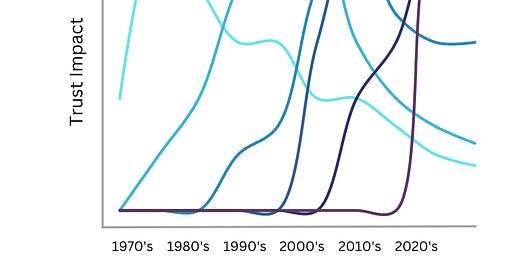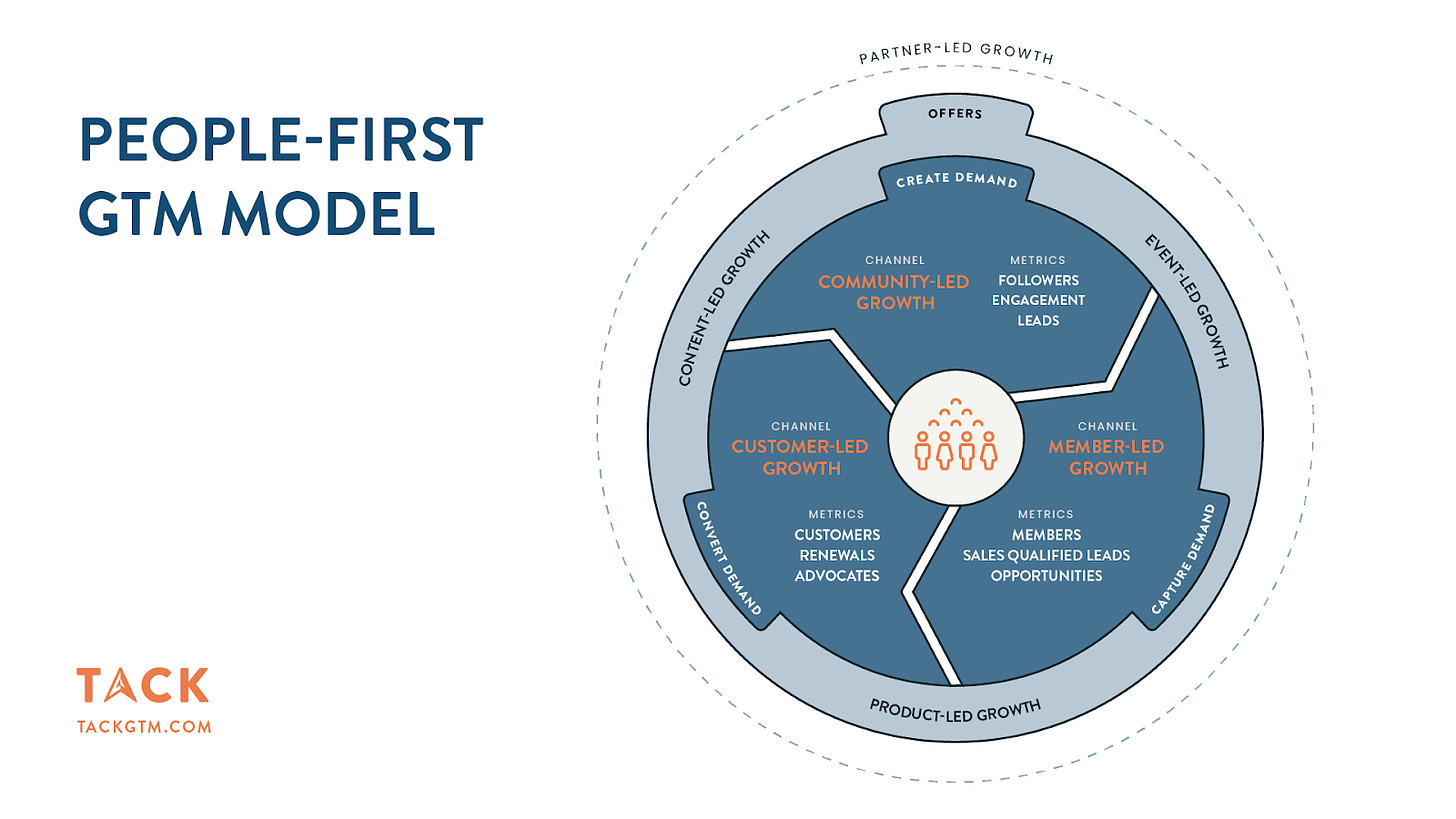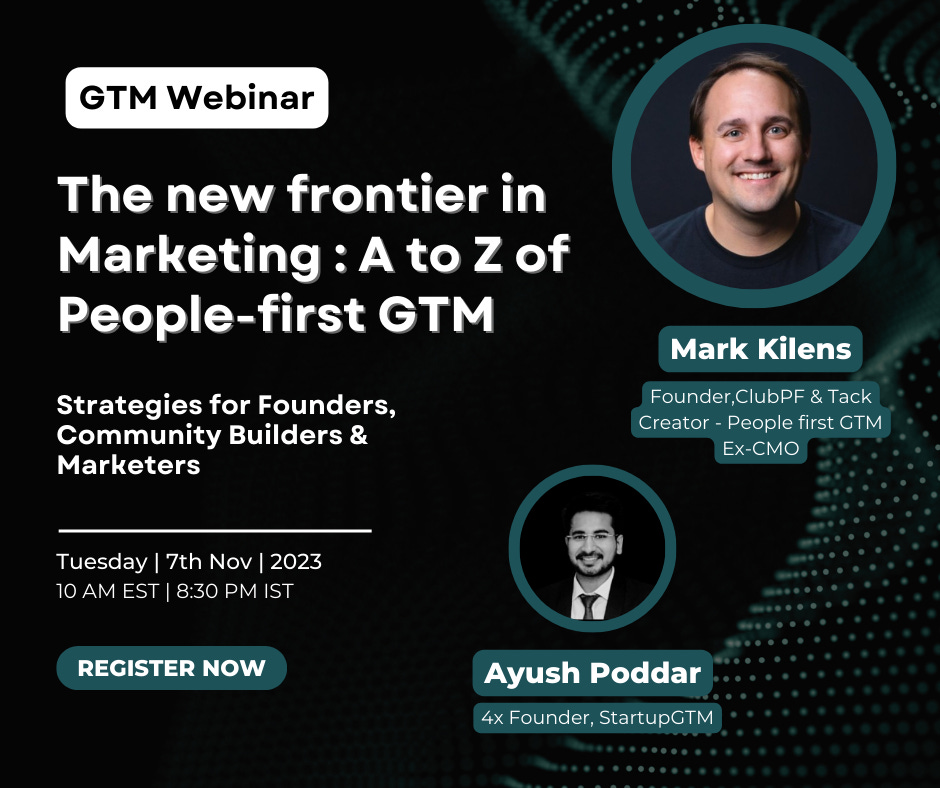Why is People-first GTM considered the new marketing frontier?
Uncover the shift from company-first to people-first strategies in marketing, and learn why fostering genuine relationships is the key to enduring business success.
👋 Hey, Ayush here! Welcome to this week’s ✨ free edition ✨ of Startup GTM Newsletter. Daily, I work with founders and understand their questions about GTM, growth, people-first strategies, communities and anything else about building a startup.
Subscribe to receive every post. Follow me on Linkedin and Twitter. Want to discuss about your GTM? Setup a meeting on this link .
Lately, People-first GTM has caught my attention as the new approach in marketing. It's about shifting focus from company-centric to people-centric strategies. This isn't just a trend, I believe it's a response to customers wanting real connections in a digital world.
Over the course of the last five decades, the marketing arena has witnessed a dynamic evolution, transitioning through various marketing strategies to forge stronger connections between businesses and their audiences. As a founder and CMO, it's fascinating when I reflect back on the journey and adapt to the latest, people-first Go-To-Market (GTM) strategies. Here's a brief overview of the effectiveness of GTM strategies over a period of time.
Before we proceed ahead, do register for our upcoming webinar “The new frontier in Marketing: A to Z of People-first GTM” , which is happening on 7th Nov 8:30 PM IST, 10:00 AM EST with Mark Kilens (Creator of People-first GTM Framework)
1. Cold-Calling hot start
In the early days, cold-calling was the trailblazer, establishing a direct, human-to-human connection. It was a straightforward way to reach potential customers, setting the stage for more personalised marketing approaches.
Initial Success: Cold-calling initially thrived due to its direct human touch, allowing businesses to personally reach out to potential customers. It was highly effective during the late 80s and throughout the 90s.
Over Time: Its effectiveness started waning in the early 2000s with the advent of digital marketing channels and increasing consumer distaste for unsolicited calls.
2. Direct Response Marketing took the lead to scale
As cold-calling became a norm, direct response marketing, symbolised by hand-written sales letters, started gaining traction. These personalised letters struck a connection with recipients, generating impressive responses.
Initial Success: The personalised nature of hand-written sales letters resonated with recipients, making direct response marketing a successful follow-up to cold-calling. This strategy saw a rise in the 90s and early 2000s due to its personalised touch.
Over Time: As volumes increased, the personal touch got diluted, making it less effective. Its impact began to lessen around the mid-2000s as digital platforms started offering more scalable and less intrusive ways to connect.
3. Digital reach-out with Email Marketing:
With the internet gaining ground, email marketing started to shine. Emails, seen as modern-day letters, continued the tradition of personal communication, now on a digital platform.
Initial Success: Email marketing continued the personal touch, but on a digital platform, allowing for broader reach while maintaining a semblance of personal connection. Email marketing gained traction in the early to mid-2000s.
Over Time: Around 2010 onwards, the influx of promotional emails began to lead to lower open rates and engagement.
4. Web evolution triggered Content Marketing:
Audiences began flocking to the valuable content produced by individuals and companies, enabling a shift towards content-led / inbound marketing.
Initial Success: Content marketing saw a significant rise from the mid to late 2000s, especially with the advent of blogging platforms and later, social media.
Over Time: The saturation point started around 2015, with a massive influx of content leading to the challenge of standing out, and audience attention became fragmented
5. Social Media and Paid Advertising:
Alongside content, social media platforms and paid advertising emerged as potent channels to acquire and engage users. Brands started leveraging paid ads to amplify their reach and drive more conversions.
Social media ad spend crossed $40 billion in the US in 2020, highlighting its pivotal role in modern marketing strategies.
Initial Success: Paid ads on social platforms allowed brands to target specific audiences, initially leading to better engagement and conversion rates. The period from 2010 to around 2015 saw a boom in social media advertising with platforms like Facebook and Instagram becoming ad giants.
Over Time: Ad fatigue began setting in around 2016 onwards, with diminishing returns and rising costs per click.
6. A New Chapter with Community and Influencer Marketing:
As the digital space got saturated with content and ads, the spotlight moved to creators, community builders, influencers, and partnership channels. These avenues provided a more authentic and engaging way to connect with audiences.
Initial Success: Around 2015, influencer marketing began gaining traction, offering a fresh, authentic channel for brand promotion.
Over Time: The influencer space started showing signs of authenticity concerns around 2018 onwards.
7. The AI Wave and People-first GTM Emergence:
Now, in an AI-driven era, customers are being inundated with algorithm-optimized content. Amidst this, People-first GTM emerges as a logical framework to rebuild trust between companies and potential customers. This approach champions human-centric interactions amidst a digital whirlpool, orchestrating multiple GTM motions to foster a long-term growth journey for companies.
Initial Success: AI-driven strategies have enhanced efficiency and targeting, while People-first GTM strategies have reintroduced the human touch, building trust. This is a recent trend we have observed over the last couple of years.
Over Time: The full impact of People-first GTM is yet to be seen, but the constant evolution of AI will require a balanced approach to maintain human-centric interactions amidst advancing automation.
People-first GTM
Mark Kilens and Nick Benett have started an initiative named ClubPF (Club People-first), introducing the innovative framework of People-first GTM (Go-To-Market). This model champions the shift from a company-centric to a people-centric strategy, marking a significant stride in modern marketing approaches.
The framework unfolds through a logical progression of trust-building; initiating in external communities on platforms like LinkedIn, Facebook, and other social mediums, transitioning to nurturing trust within owned member communities crafted on channels like Slack, Discord, Whatsapp, Guild, Mighty, and then escalating to trust cultivation through customer-led endeavours such as Podcasts, Case Studies, Interviews, and Speaker Events.
A common thread of partnerships weaves through all these stages, enriching the trust-building journey. The buzz around "People-first GTM" is fueled by contemporary challenges like the explosion of algorithm-optimised content, channel saturation leading to fiercer competition and lower ROI, a cookieless future emphasising privacy and first-party data, a connection crisis birthed from the shift to remote and hybrid work models, and the convergence of AI fostering efficiency and automation.
The People-first approach offers a solution to these challenges, putting human connections back at the heart of business interactions. This way, not only do we see more meaningful conversations and better leads, but it also helps create demand, build strong relationships, and promotes a focus on partnerships, setting up companies for long-term growth.
As designed by Mark and Nick, the People-first GTM Model looks like this…
Questions to address
Here are 10 pertinent questions that a CMO needs to consider while planning for GTM strategies:
How does transitioning to a People-first GTM strategy contribute to building long-term sustainable relationships, improving lead quality, creating demand, and fostering meaningful interactions for our business?
In a cookie-less future with an emphasis on privacy and first-party data, how can we adapt our data collection and analysis strategies to remain compliant and effective?
Given the content explosion and algorithm-optimized content, how can we ensure our content stands out and resonates with our target audience?
How can we navigate channel saturation to maintain or improve ROI in a competitive marketplace?
How can we integrate a common layer of partnerships across all stages to enhance our GTM strategy?
How can we leverage our existing customers (through initiatives such as podcasts, case studies, interviews, and speaker events) to build trust and engage with them?
With the shift to remote and hybrid work, how can we maintain meaningful connections with our audiences and foster engagement with the brand?
How can we build and nurture trust within external communities on social media platforms like LinkedIn, Facebook, and other platforms like Slack, Discord, Whatsapp, Guild, Mighty, etc.?
Is there a way to build an owned member community for long-term business growth, and what strategies can be employed?
How can we leverage AI for efficiency and automation while still maintaining a people-first approach in our GTM strategies?
Still confused on HOW? We have a live interaction scheduled…
Join us for an enlightening webinar with Mark Kilens on “The new frontier in Marketing: A to Z of People-first GTM”
Link - https://lu.ma/vu09dfzz
Time - 7th Nov 8:30 PM IST, 10:00 AM EST
Key Takeaways:
Understand why and how the People-first GTM strategy is taking the business world by storm.
Real-world examples of high growth companies leveraging People-first GTM to their advantage.
Practical insights to scale and enhance your Go-to-market strategy with the power of People-first GTM.
About Mark Kilens:
The brilliant mind behind the People-first GTM Framework.
Founder of Tack & ClubPF.
Previously showcased expertise as a Marketing Leader at giants like Airmeet, Drift, and Hubspot.
Ready to supercharge your startup's go-to-market strategy? Subscribe to our newsletter for exclusive insights, tips, and expert advice. Plus, schedule a 1:1 GTM brainstorming meeting with Ayush through Calendly link!







